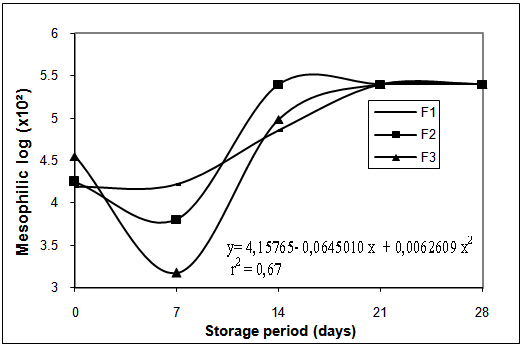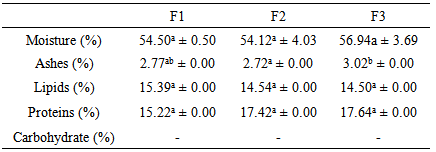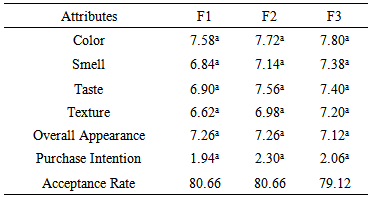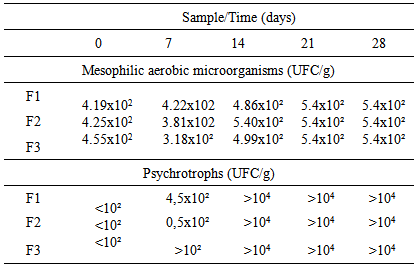-
Paper Information
- Previous Paper
- Paper Submission
-
Journal Information
- About This Journal
- Editorial Board
- Current Issue
- Archive
- Author Guidelines
- Contact Us
International Journal of Food Science and Nutrition Engineering
p-ISSN: 2166-5168 e-ISSN: 2166-5192
2014; 4(3): 86-90
doi:10.5923/j.food.20140403.05
Sensorial, Microbiological, and Physico-Chemical Analysis of Minas Frescal Cheese with Oregano Essential Oil (Origanum Vulgare) Addition
Jackeline dos Reis Santos1, Suzan Paula Gomes Hafemann1, Gabriella Giani Pieretti2, Jessica Lorraine Antigo2, Magali Soares dos Santos Pozza3, Monica Regina da Silva Scapim1, Grasiele Scaramal Madrona1
1Department of Food Engineering, State University of Maringá, Paraná, Brazil
2Department of Food Science, State University of Maringá, Paraná, Brazil
3Department of Animal Science, State University of Maringá, Paraná, Brazil
Correspondence to: Grasiele Scaramal Madrona, Department of Food Engineering, State University of Maringá, Paraná, Brazil.
| Email: |  |
Copyright © 2014 Scientific & Academic Publishing. All Rights Reserved.
This study aims to evaluate, from production to shelf-life, the physico-chemical, sensorial, and microbiological characteristics of minas frescal cheese made with oregano essential oil. Three samples F1, F2, and F3 were prepared with different levels of essential oil concentration and evaluated using the hedonic scale for attributes such as color, flavor, texture, odor, and overall evaluation. The physico-chemical analysis included the determination of moisture, total fat, ash, protein, and carbohydrates which were evaluated by ANOVA and Tukey test (p<0.05). The samples were analysed for Staphylococcus coagulase positive, mesophilic, psychrotrophic, coliforms, and Salmonella at 0, 7, 14, 21, and 28 days. Results for Staphylococcus coagulase positive, aerobic mesophilic, psychrotrophic, coliforms, and salmonella were found within the limits established by applicable Brazilian legislation. The sensory acceptance rates were satisfactory, being greater than 70 % at all concentrations, suggesting that the insertion of oregano essential oil cheese in the consumer market is feasible at the evaluated concentrations.
Keywords: Sensory acceptance, Flavoring, Antimicrobial action
Cite this paper: Jackeline dos Reis Santos, Suzan Paula Gomes Hafemann, Gabriella Giani Pieretti, Jessica Lorraine Antigo, Magali Soares dos Santos Pozza, Monica Regina da Silva Scapim, Grasiele Scaramal Madrona, Sensorial, Microbiological, and Physico-Chemical Analysis of Minas Frescal Cheese with Oregano Essential Oil (Origanum Vulgare) Addition, International Journal of Food Science and Nutrition Engineering, Vol. 4 No. 3, 2014, pp. 86-90. doi: 10.5923/j.food.20140403.05.
Article Outline
1. Introduction
- Even though food additives are added with the intent of improving consumers’ health, the demand for chemically added ingredients has been decreasing over time. As consumers give more preference to naturally made food, several studies have been developed in order to find natural substitutes to chemical additives that could perform as well as chemical additives in terms of antimicrobial potential [1].The use of plant’s secondary metabolites additives, for example, has been increasing mainly due to its health benefits as well as reduced impact on the environment. Such metabolites proved to be efficient in terms of antimicrobial properties; therefore, they have great potential to be employed in the food industry, mainly where the risk of contamination during product preparation is high. In that case, the use of natural inhibitory substances is highly attractive [2].Studies conducted using essential oils extracted from many different plants have demonstrated that such oils perform well in preventing microorganism’s deterioration, having great antimicrobial activity properties [3].According to the International Standard Organization (ISO) 9235:1997, essential oils are defined as products obtained from plants through steam distillation. In general, they are complex mixtures of volatile and lipophilic substances, generally liquid and odoriferous [2].Oregano (Origanum vulgare Linneus, family Lamiaceae) is a plant with a pleasant smell and has an herbaceous and intense flavour. One of its main components is its oil. Oregano’s chopped flowers and leaves are widely used for aromatic and seasoning purposes [3].According to Souza et al. [1] when studying the antimicrobial potential of spices it is noticeable that oregano is widely used for inhibiting bacteria and fungi contamination in food.In Brazil, there are several types of both handmade and industrially produced fresh cheeses, produced both by small producers and industries [5].The dairy industry has great social and economic relevance, especially concerning cheese production, occupying the sixth position in world production. The greatest parcel of the Brazilian annual cheese output consists in the production of popular consumption cheeses, such as the minas frescal cheese, mozzarella, ricotta, prato cheese, and parmesan [6]. Among these, the minas frescal cheese has the higher moisture, thus having shorter shelf-life. Most of the studies about essential oils additions, evaluate their microbiological characteristics without assessing the sensorial quality of the obtained product. Seeking a broader approach, this study aims to evaluate the microbiological, sensorial, and physicochemical properties of minas frescal cheese made with oregano essential oil addition, using three different formulations.
2. Materials and Methods
- The three studied formulations of Minas frescal cheese tested in this study were produced in the Laboratory of Food Engineering of State University of Maringa. The ingredients were purchased in local markets in the city of Maringa with exception of the oregano oil that was donated by Ferquim®.
2.1. Processing the Minas Frescal Cheese
- The basic formulation of the minas frescal cheese was composed of 97.9% of pasteurized non-homogenized milk, 0.03% of calcium chloride, 1.5% of salt and 0.15% of rennet. Different concentrations of oregano essential oil were used in the samples; the control sample, F1, had no essential oil addition while F2 had addition of 0.0075% and F3 0.015%. These concentrations were defined in preliminary tests. The preparation of the samples was made according to recommendations of FURTADO and LOURENÇO-NETO [7]. Right after production, the samples were submitted to percent composition, microbiological, and sensorial analyses. Part of the product was stored in BOD, at 5ºC during 28 days for microbiological analysis.
2.2. Percent Composition Analysis
- Both moisture and ashes analyses were carried out according to recommendations by Adolfo Lutz Institute [8]. The lipids analysis was carried out using the Bligh & Dyer – BD method [9], the protein analysis was performed according to recommendations of AOAC [10], and the carbohydrate analyses was carried out using the method of difference.
2.3. Sensorial Analysis
- The obtained products were submitted to sensorial analysis using a hedonic scale test in order to check whether there had been representative flavour difference between the minas frescal cheese prepared with oregano oil addition. A nine-point hedonic scale (9= really liked it; 5= indifferent, and 1= really disliked it) was used to evaluate color, smell, taste, texture, overall appearance, and purchase intention (with 3-point scale).Fifty non-trained tasters participated in the test; each one received simultaneously 3 samples of minas frescal cheese with three different concentrations of oregano oil codified with three digits in a randomized order, along with a glass of water at room temperature (25ºC) to rinse out their mouth between samples. The test was conducted in the laboratory of sensory analysis of Food Engineering of State University of Maringa in booths with fluorescent lamps (daylight) and with an approving position by the UEM Ethics Committee, CAAE: 04021812.4.0000.0104.The acceptance rate (IA) of the developed products was calculated through equation 1.
 | (1) |
2.4. Microbiological Analyses
- Samples were tested on the day of preparation, then at 7, 14, 21, and 28 days of storage for coagulase positive Staphylococci, aerobic mesophilic bacteria, psychrotrophs, thermotolerants, total coliforms (at 35ºC and 45ºC), and Salmonella according to a methodology suggested by SILVA et al. [11].
2.5. Statistical Analysis of Data
- Results were analysed statistically using analysis of variance (ANOVA). The samples which differed significantly had their averages calculated through Tukey at 95% probability by SAS [12].
3. Results and Discussion
3.1. Percent Composition
- The percent composition of minas frescal cheese with different oregano oil concentrations is described in table 1.
|
3.2. Sensorial Analysis
- Table 2 presents the results of sensorial analysis of minas frescal cheese.
|
3.3. Microbiological Analysis
- According to Technical Regulations for Identity and Quality of Dairy Products [13], the microbiological limits for cheeses with high humidity content, tempered, spiced or with herbs addition or other ingredients are of 102 for Coliforms at 45ºC/g, 103 Staphylococcus coagulase positive (UFC/g) and absence for Salmonella/25 g.Results of mesophilic and psychrothrophyc micro-organisms are presented in Table 3.
|
 | Figure 1. Regression for mesophilic aerobic microorganisms at periods assessed (0, 7, 14, 21 and 28 days) |
4. Conclusions
- Concerning the physical and chemical parameters, the addition of oregano oil did not have direct influence on the cheese composition. The sensorial analysis of all samples did not show significative differences for the attributes assessed (color, taste, smell, texture, overall appearance, and purchase intention).The resulting acceptance rate was above 70%, which is considered good. In addition, a low concentration was observed for every microorganism researched, which is compliant with the microbiological standards required by law. Thus, the conclusion is that combining minas frescal cheese with oregano essential oil would be welcomed by the consumers market, especially because the oil acts as a natural food preservative for cheese, in contrast with chemical additives, causing shelf-life to be increased.
ACKNOWLEDGEMENTS
- This research was funded by the Araucaria Foundation of the state of Paraná, Brazil, the National Council for Scientific and Technological Development (CNPq).
 Abstract
Abstract Reference
Reference Full-Text PDF
Full-Text PDF Full-text HTML
Full-text HTML

